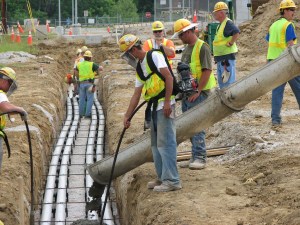
27 Dec Concrete Construction Safety
Concrete Construction Safety
 Concrete is a versatile and strong material for construction. Concrete workers are just as versatile when performing excavations, carpentry, metalworking, pouring, and smoothing to create concrete structures. Pay attention to the variety of hazards while you work with concrete.
Concrete is a versatile and strong material for construction. Concrete workers are just as versatile when performing excavations, carpentry, metalworking, pouring, and smoothing to create concrete structures. Pay attention to the variety of hazards while you work with concrete.
Personal protection equipment (PPE) keeps you safe on the job. For digging, forming, and exposure to concrete, wear sturdy gloves and safety boots to protect your hands and feet. A hard hat protects your head from falling objects and bumps. Consider ear plugs depending on the noise level of your equipment and job site. Safety glasses and face shields protect your eyes from flying dust, wood chips, and concrete. A respirator protects your lungs from concrete dust and dirt.
You may dig and remove vegetation before you lay forms for concrete. Check the work area for underground utilities and services first. Use of sharpened tools makes digging footings and cutting back obstacles (such as roots and branches) easier. When possible, use powered equipment for digging and moving most of the dirt and gravel. Finish the final digging using hand tools.
Preparing concrete forms requires carpentry skills, and hand and power tools. Inspect your tools to ensure they are in good working order. Saws should be properly guarded to protect your hands and fingers. Use power tools that are double insulated or grounded with a three-prong plug and connected to ground fault circuit interrupters (GFCI) to prevent electric shock in case the tool comes into contact with moisture.
Design and build forms to adequately and safely hold the proper amount of concrete. Keep plans of the forms and finished product on the worksite. If the forms need shoring, use sills that are rated for the load and in good condition. Inspect shoring equipment before, during, and after you add concrete.
Take care when cutting and shaping reinforcing materials. Use a proper blade and cutting tool for the material you use. Do not allow sparks to land on flammable materials while you cut. Support metal formations so they do not collapse. Cover sharp rebar ends to prevent impalement injuries. Prevent wire mesh recoil by securing the ends or turning the roll over.
Concrete can be applied to an area by hand, chute, pneumatic hoses, or buckets. For pneumatics, check the hoses and couplings to prevent a breach. Anchor the hose in place to prevent excess movement. Do not ride concrete buckets or hoist/swing the buckets over workers.
Once the forms are built and the concrete pumped, use tools with handles to smooth the surfaces. Use the larger muscles of your shoulders to move the trowel and avoid twisting your back. If you are smoothing a walking surface, bend your legs, not your back, and apply the trowel. Consider wide mats and knee pads to help you access areas that need smoothing.
Do not remove forms and shores until the concrete has cured and gained strength. Form removal (except at grade) should be done according to the specifications for the concrete cure time or if the concrete has been strength tested.

